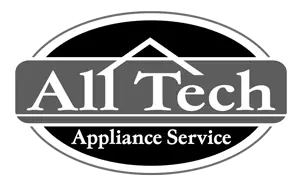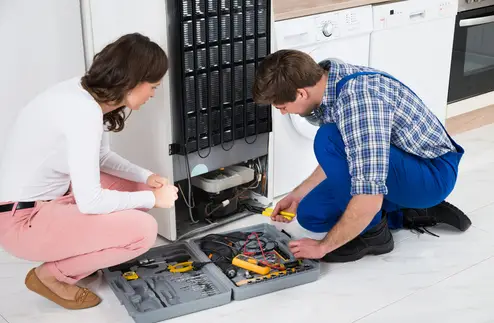How to Fix a Refrigerator Not Cooling: Tips from All Tech Appliance
Is your refrigerator not cooling properly? This issue can be frustrating, especially when your food is at risk of spoiling. If you’re wondering how to fix a refrigerator not cooling, you’re in the right place. At All Tech Appliance, we’ve seen all kinds of refrigerator problems and have helped many Beaverton residents get their fridges back in working order. Here, we’ll explain how to tell if your fridge is working, common causes for a fridge not cooling, and actionable steps you can take to troubleshoot before calling in a professional.
How to Tell If Your Refrigerator is Working Properly
Before you start troubleshooting, it’s important to know how to tell if the refrigerator is working properly. It can sometimes be a simple fix or a sign that the appliance is in need of serious repair. Here are a few key indicators that will help you assess the situation:
- Temperature Check: The most obvious sign of a fridge that isn’t working properly is the temperature. A functioning refrigerator should keep your food at or below 40°F (4°C). If the fridge feels warm, it’s a clear sign that it’s not cooling properly.
- Frost Build-Up in the Freezer: If frost builds up in your freezer or if the freezer isn’t freezing, there may be an issue with the fridge’s cooling system.
- Strange Sounds: Refrigerators usually make a low hum while they’re running. However, if you hear clicking, buzzing, or loud noises, it might be an indication of an issue with the compressor or condenser fan.
- Leaks or Puddles of Water: If you notice puddles of water at the bottom of your refrigerator, or if there’s condensation on the inside walls, it could be another sign that the fridge isn’t working as it should.
- The Door Seals Aren’t Tight: Inspect the door seals for any damage or dirt buildup. If the door seals are cracked or dirty, cool air may be leaking out, which could affect the fridge’s cooling ability.
Common Causes for a Refrigerator Not Cooling

Understanding why your fridge isn’t cooling is key to fixing the problem. Here are some common causes:
Dirty Condenser Coils
The condenser coils release the heat absorbed from inside the refrigerator. If they are dirty, the fridge may struggle to cool effectively. Dust and dirt can build up on the coils over time, especially if the fridge is placed in a dusty or tight space.
Solution: Check the coils on the back or beneath your refrigerator. To clean dirty or dusty coils, use a vacuum cleaner or a coil cleaning brush. It’s a simple fix that can often restore your fridge’s cooling ability.
Faulty Thermostat
The thermostat controls the temperature inside the fridge. If it’s malfunctioning, the fridge may not cool correctly or it may fail to turn on.
Solution: Try adjusting the thermostat settings. If that doesn’t help, you may need to replace the thermostat. This is a common issue in older refrigerators.
Defective Evaporator Fan
The evaporator fan helps distribute cool air throughout both the fridge and freezer. If this fan is broken or malfunctioning, it can prevent the refrigerator from cooling properly.
Solution: Listen for a sound from the fan when the fridge is running. If you don’t hear anything, the fan may need to be replaced.
Compressor Problems
The compressor serves as the core of the refrigerator’s cooling system. If it malfunctions, the refrigerator will completely lose its ability to cool.
Solution: Unfortunately, a faulty compressor usually requires professional repair or replacement. If you suspect the compressor is the issue, it’s time to call in an expert like All Tech Appliance.
Low Refrigerant Levels
Refrigerants are the chemicals responsible for cooling the air inside the refrigerator. If your refrigerator is low on refrigerant, it won’t cool effectively.
Solution: This is a more complicated issue and typically requires the help of a professional technician. They will need to check for leaks and refill the refrigerant as necessary.
How to Fix a Refrigerator Not Cooling
If you’re dealing with a fridge that’s not cooling, there are several steps you can take to troubleshoot the problem:
- Unplug and Restart
Sometimes, a simple reboot can fix minor issues with your refrigerator. Try unplugging the appliance for several minutes, then plug it back in to reset it. This can reset the internal components and may restore its cooling function.
- Check the Temperature Settings
Ensure that the fridge and freezer are set to the correct temperatures. The recommended temperature for the refrigerator is at or below 40°F (4°C), while the freezer should be set to 0°F (-18°C). If the settings have been changed accidentally, adjusting them might fix the issue.
- Inspect the Condenser Coils
As mentioned earlier, dirty condenser coils can cause cooling problems. Clean the coils and check if the fridge starts cooling again. If the coils look fine, move on to other troubleshooting steps.
- Defrost the Freezer
If there’s excessive ice build-up in the freezer, it can block airflow and prevent the fridge from cooling. Defrosting the freezer can resolve this problem. You can either let the ice melt naturally or use a hairdryer to speed up the process (be careful not to damage the appliance).
- Examine the Door Seals
Check the door seals for any damage. If you notice any cracks, tears, or dirt, replace the seals or clean them. A tight seal ensures cool air stays inside, which is crucial for proper cooling.
FAQs
1. How can I tell if my refrigerator is working?
You can tell if your fridge is working by checking the internal temperature, listening for any strange sounds, and inspecting the door seals. If the fridge isn’t keeping food cold or has excessive frost buildup, it might not be working properly.
2. Why is my refrigerator not cooling?
Common reasons include dirty condenser coils, a malfunctioning thermostat, a faulty evaporator fan, or a defective compressor. Low refrigerant levels can also contribute to cooling issues.
3. What should I do if my refrigerator isn’t cooling properly?
Start by cleaning the condenser coils, adjusting the temperature settings, and ensuring the door seals are tight. If the issue continues, it’s best to contact a professional technician for assistance.
4. Should I repair or replace my refrigerator?
If your fridge is older or the repair costs are high, it may be more cost-effective to replace it. However, for relatively new fridges, repairing the appliance is often the better option.
When to Call a Professional
If the refrigerator still isn’t cooling after following these steps, it may be time to consult a professional technician. At All Tech Appliance, we specialize in refrigerator repair and are committed to providing top-notch service to Beaverton residents. A technician can help diagnose more complex issues, such as a faulty compressor or refrigerant leaks, and recommend the best solution.
Serving Top Locations:
All Tech Appliance is proud to serve a wide range of locations, including Beaverton, Gresham, Tigard, Lake Oswego, Happy Valley, and Clackamas . Our expansive service area ensures that more customers can benefit from our expert appliance repair services. No matter where you are located within these areas, we are just a call away, ready to provide prompt and reliable repair solutions.


